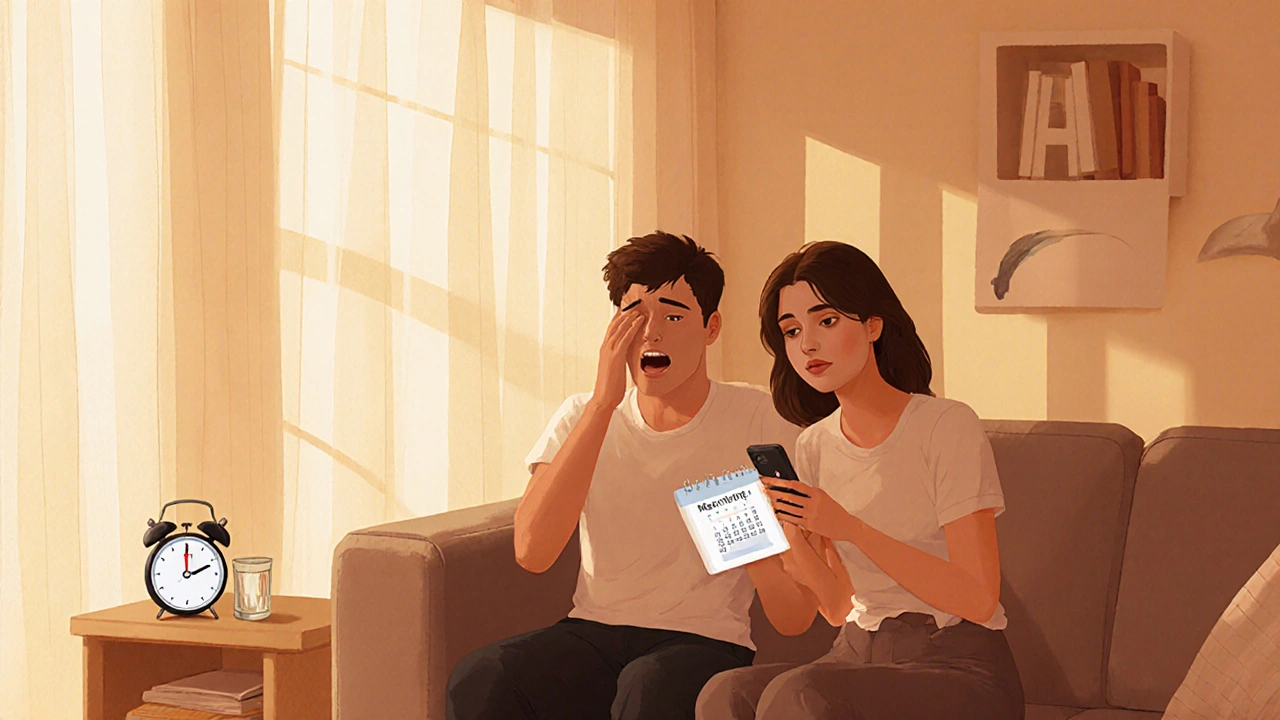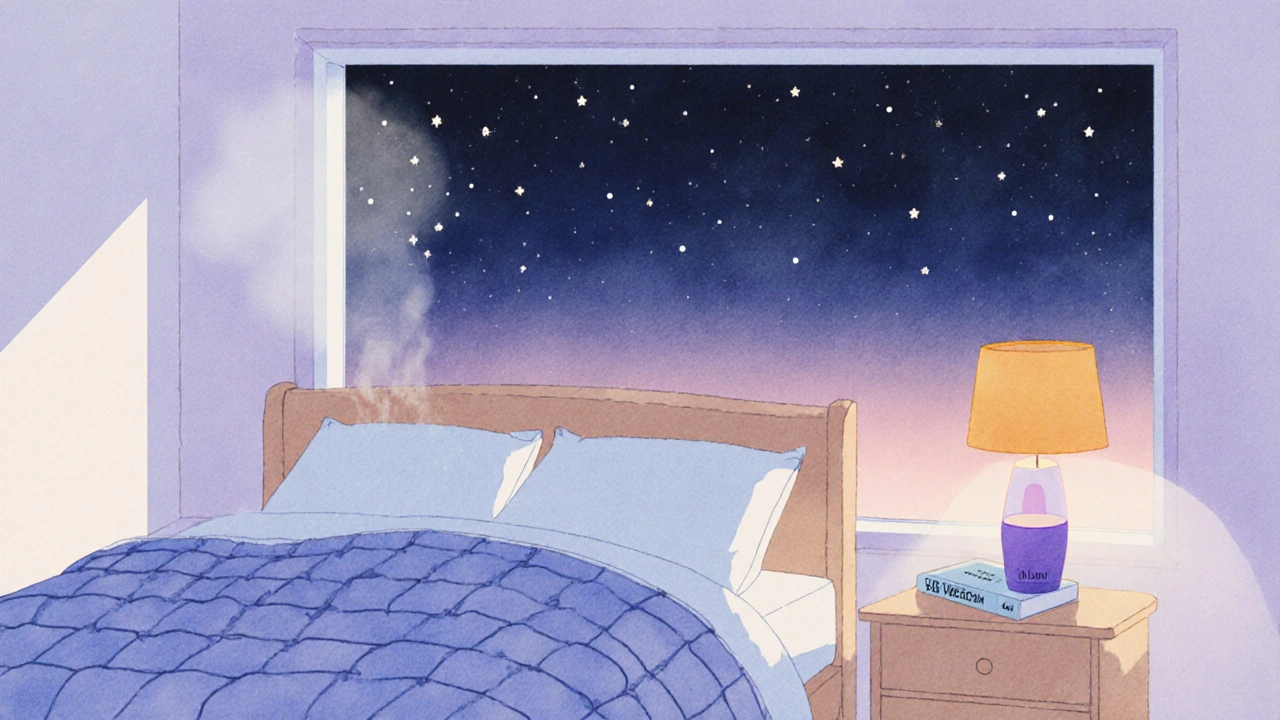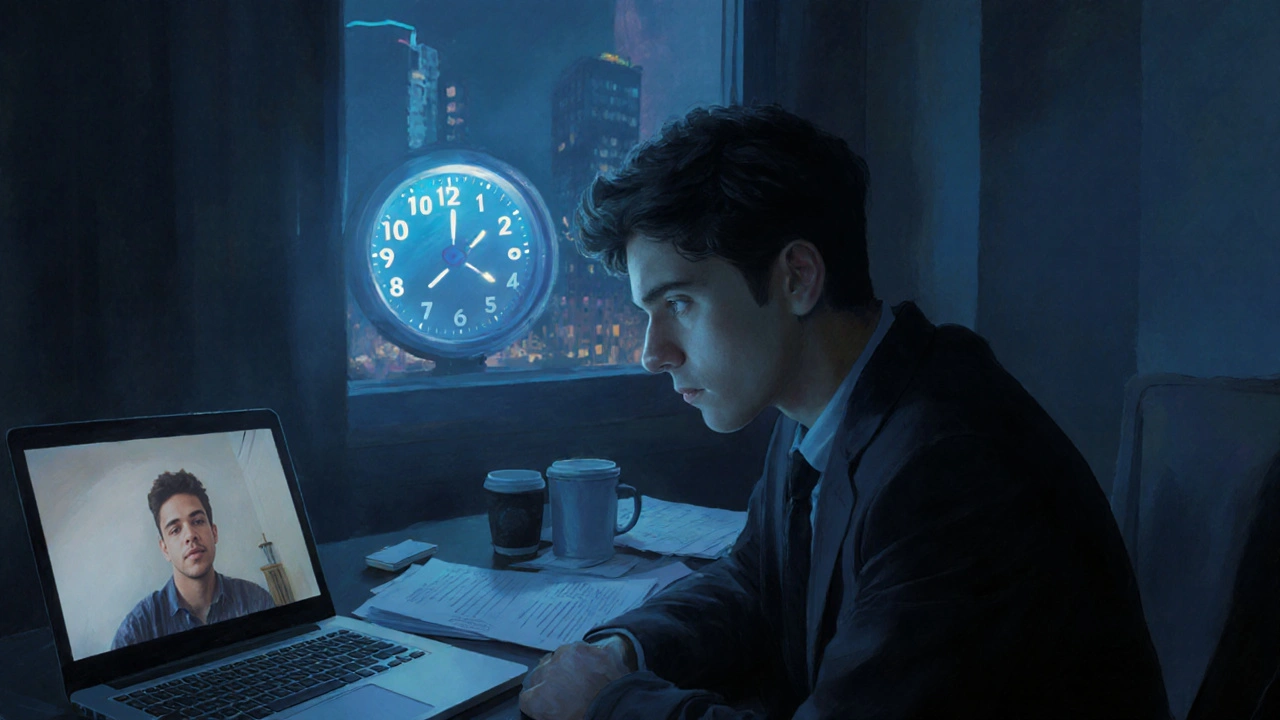Imagine waking up at 11am, feeling exhausted, and still missing the morning meetings you promised to attend. For many people, that isn’t a rare bad day - it’s a daily reality caused by Delayed Sleep Phase Syndrome (DSPS). This hidden sleep disorder quietly reshapes everything from your mood to your career, and most of us don’t even realize why.
Key Takeaways
- DSPS shifts your internal clock later, making it hard to fall asleep before the early morning.
- The disorder lowers physical health, spikes anxiety and depression, and messes with work performance.
- Underlying causes include a misaligned circadian rhythm and altered melatonin release.
- Effective strategies involve timed bright‑light exposure, melatonin supplementation, and strict sleep‑hygiene routines.
- Early diagnosis and personalized treatment can restore a healthier quality of life.
What Is Delayed Sleep Phase Syndrome?
Delayed Sleep Phase Syndrome is a chronic circadian‑rhythm sleep disorder where the sleep‑wake cycle is delayed by two or more hours relative to societal norms. People with DSPS typically cannot fall asleep before 2am-4am, yet they wake up naturally after 10am if allowed. The condition is not simply “staying up late” - it’s a physiological misalignment that persists even when lifestyle changes are attempted.
While anyone can develop DSPS, research shows a higher prevalence among teenagers, shift workers, and those with a family history of circadian‑rhythm disorders. The International Classification of Sleep Disorders (ICSD‑3) lists DSPS under the umbrella of “Circadian Rhythm Sleep‑Wake Disorders,” underscoring its neurological basis.
How DSPS Touches Every Corner of Your Life
Because sleep is the foundation of virtually every bodily system, a chronic shift in sleep timing ripples through multiple domains.
Physical Health
Late‑night wakefulness often means reduced exposure to daylight, which can lower vitaminD synthesis and impair immune function. Studies from the University of Sydney (2023) found that adults with DSPS reported a 15% higher incidence of metabolic syndrome markers compared with age‑matched controls.
Irregular sleep also disrupts glucose metabolism. A 2022 meta‑analysis showed that delayed sleepers had a 1.3‑fold increased risk of developing type2 diabetes, likely due to altered insulin sensitivity during abnormal sleep phases.
Mental Health
The mismatch between internal clocks and external demands fuels chronic stress. Mood‑disorder prevalence is striking: up to 40% of DSPS patients meet criteria for major depressive disorder, and 30% for generalized anxiety disorder, according to a longitudinal study at Monash University.
Beyond depression and anxiety, the disorder erodes cognitive function. Executive‑function tests reveal slower reaction times and poorer working‑memory scores in delayed sleepers, especially when forced to attend early‑morning tasks.
Social & Occupational Performance
Missing conventional work hours translates into reduced job opportunities and lower income. A 2024 Australian Bureau of Statistics report linked DSPS to a 12% wage gap for affected individuals, primarily due to part‑time or freelance employment.
Social life suffers too. Evening‑oriented schedules clash with family meals, school pick‑ups, and community events, leading to feelings of isolation. Over time, the cumulative loss of social interaction can aggravate the very mood disorders that DSPS helps create.
Why Does the Clock Tick Wrong? The Biology Behind DSPS
The master clock resides in the suprachiasmatic nucleus (SCN) of the hypothalamus. It receives light cues through the retina, translating daylight into hormonal signals-chiefly the timing of melatonin release.
In DSPS, the SCN’s phase is delayed. This can stem from genetic variations (e.g., PER3, CRY1 mutations) or environmental factors like excessive evening screen exposure. When melatonin peaks later than usual, the body’s “sleep‑ready” signal arrives after midnight, making early bedtimes feel impossible.
Beyond genetics, lifestyle habits exacerbate the delay. Blue‑light from phones suppresses melatonin, while irregular meal times shift peripheral clocks in the liver and gut, creating a feedback loop that entrenches the disorder.

Managing DSPS: From Light to Lifestyle
Fortunately, DSPS is not a life sentence. Treatment hinges on resetting the circadian clock through timed stimuli.
Bright‑Light Therapy
Light therapy involves exposure to 10,000 lux of white or blue light for 20‑30minutes each morning, ideally within an hour of waking. The light signal tells the SCN to advance the clock, nudging bedtime earlier.
Clinical trials show that consistent morning light can advance sleep onset by up to 90minutes after four weeks, reducing daytime sleepiness dramatically.
Melatonin Supplementation
Timed low‑dose melatonin (0.3-0.5mg) taken 3‑5hours before the desired bedtime can shift the phase earlier. The key is timing; taking melatonin too early can worsen the delay.
Research from the Sleep Medicine Center in Melbourne (2022) indicates that melatonin, combined with light therapy, yields the greatest improvement-up to a two‑hour advance in sleep onset within six weeks.
Sleep‑Hygiene Overhaul
Good sleep hygiene creates a stable environment for the circadian system to function. Core practices include:
- Turning off all screens at least one hour before target bedtime.
- Keeping bedroom temperature between 16‑19°C.
- Using blackout curtains to ensure darkness after lights‑out.
- Maintaining a consistent wake‑time, even on weekends.
While simple, these changes amplify the effects of light and melatonin therapies.
Cognitive‑Behavioral Therapy for Insomnia (CBT‑I)
CBT‑I targets the anxiety and rumination that often accompany DSPS. By restructuring thoughts about sleep and teaching relaxation techniques, patients experience reduced sleep latency and better daytime alertness.
Chronotherapy
Chronotherapy gradually shifts bedtime later by 1‑2hours each night until the desired schedule is reached. Though effective for some, it requires strict adherence and supervision to avoid worsening the disorder.
Practical Checklist for Living with DSDS
| Time | Action | Why It Helps |
|---|---|---|
| 6:30am - 7:30am | Bright‑light exposure (10,000lux) | Advances circadian phase |
| 9:30pm | Take 0.5mg melatonin | Signals the body to start winding down |
| 10:00pm - 10:30pm | Screen‑free relaxation (reading, meditation) | Reduces blue‑light suppression of melatonin |
| 10:30pm | Lights out, cool bedroom | Creates optimal sleep environment |
| 7:00am - 8:00am | Morning walk or light exercise | Boosts alertness, reinforces early wake‑time |
When to Seek Professional Help
If you’ve tried the above steps for more than eight weeks and still struggle with chronic fatigue, mood swings, or work‑performance issues, it’s time to consult a sleep specialist. A polysomnography study can rule out co‑existing disorders like obstructive sleep apnea, while a detailed chronobiology assessment helps tailor therapy.
Bottom Line
Living with Delayed Sleep Phase Syndrome doesn’t have to mean surrendering your career, relationships, or health. By understanding the biology, tracking your patterns, and applying targeted interventions-bright‑light exposure, timed melatonin, solid sleep hygiene-you can realign your internal clock and reclaim a better quality of life.

Frequently Asked Questions
Is DSPS the same as insomnia?
Not exactly. Insomnia is difficulty falling or staying asleep despite adequate opportunity, whereas DSPS is a misalignment of the internal clock that makes conventional bedtimes feel impossible. You can have both, but their treatments differ.
Can teenagers outgrow DSPS?
Many adolescents show a natural phase delay that eases in early adulthood. However, for a subset the delay persists and becomes chronic. Early intervention with light therapy and consistent sleep schedules can improve outcomes.
How long does melatonin take to work?
When taken at the correct time (3‑5hours before the desired bedtime), low‑dose melatonin often produces a noticeable shift within 3‑5days. Full adaptation may require 4‑6weeks of consistent use.
Is bright‑light therapy safe?
For most people, short‑duration exposure to 10,000lux is safe. Those with bipolar disorder, eye conditions, or photosensitivity should consult a doctor before starting.
Can I use a regular alarm clock to fix DSPS?
An alarm can enforce a wake‑time, but without shifting the underlying clock, you’ll likely feel even more fatigued. Pairing an alarm with morning light exposure and evening melatonin is far more effective.





KALPESH GANVIR
September 30, 2025 at 07:14I used to think I was just lazy until I found out I had DSPS. Waking up at 11am wasn’t a choice-it was my body screaming for survival. Light therapy changed everything. Now I get up at 7am without an alarm, and honestly? I feel like a different person. No more crushing guilt. No more missed meetings. Just… peace.
April Barrow
October 1, 2025 at 10:56The melatonin dosage advice here is spot on. 0.3 to 0.5mg is critical. Higher doses often backfire by causing grogginess or phase delays. Timing matters more than quantity. Consistency beats intensity every time.
Melody Jiang
October 3, 2025 at 02:19It’s wild how society treats sleep like a moral failing. We praise people who wake up at 5am like they’ve earned some kind of virtue badge, but for those of us with DSPS, that’s not discipline-it’s torture. The real issue isn’t the clock. It’s that our systems were never designed to accommodate biological diversity. Maybe we need to stop asking people to change their bodies and start changing the schedule.
alex terzarede
October 3, 2025 at 17:02CBT-I helped me more than anything. I wasn’t struggling to fall asleep-I was struggling with the fear that I’d never fall asleep. That anxiety loop was worse than the phase delay. Learning to sit with the discomfort, stop checking the clock, and trust the process made all the difference. It’s not magic. It’s just rewiring.
Dipali patel
October 5, 2025 at 16:52Wait… so you’re telling me this isn’t just a government mind control tactic to make us work longer hours? I’ve been reading about how 5G towers mess with melatonin production and they’re forcing everyone into unnatural sleep cycles. They’re using smart lights to manipulate our circadian rhythms. I’ve got a 3am routine and I’m not giving it up. They don’t want us sleeping naturally. They want us tired and obedient. The WHO won’t admit this but the data’s there if you know where to look.
Jasmine L
October 6, 2025 at 08:02Just started light therapy last week and already I’m falling asleep 45 mins earlier 😊 I know it sounds too good to be true but it’s real. Also, blackout curtains = game changer. I used to think I just needed more willpower. Turns out I just needed science.
lisa zebastian
October 6, 2025 at 16:18This whole post is corporate sleep propaganda. They want you to believe you can ‘fix’ your biology with a $200 light box and melatonin pills. Meanwhile, the real cause is systemic stress, environmental toxins, and the destruction of natural circadian rhythms by urban living. No one talks about electromagnetic pollution or how artificial lighting disrupts retinal ganglion cells. This isn’t a sleep disorder-it’s a symptom of late-stage capitalism.
Jessie Bellen
October 8, 2025 at 12:48You’re all wasting time. If you can’t sleep at 10pm, you’re just weak. Stop making excuses. My kid’s in middle school and wakes up at 6am for school. No melatonin. No light therapy. Just discipline. You’re choosing laziness.
Jasmine Kara
October 9, 2025 at 20:17i tried the light thing but it felt kinda weird like staring into a lamp? maybe i did it wrong? i just drink coffee at 6am and hope for the best lol
Richie Lasit
October 11, 2025 at 08:21Hey everyone-just wanna say you’re not broken. DSPS isn’t a flaw. It’s your body’s rhythm, and you’re not alone. I used to feel like a failure until I found a remote job that let me work 2pm–10pm. Now I’m more productive, less anxious, and actually happy. Your schedule doesn’t define your worth. Find your rhythm. Own it. You got this 💪